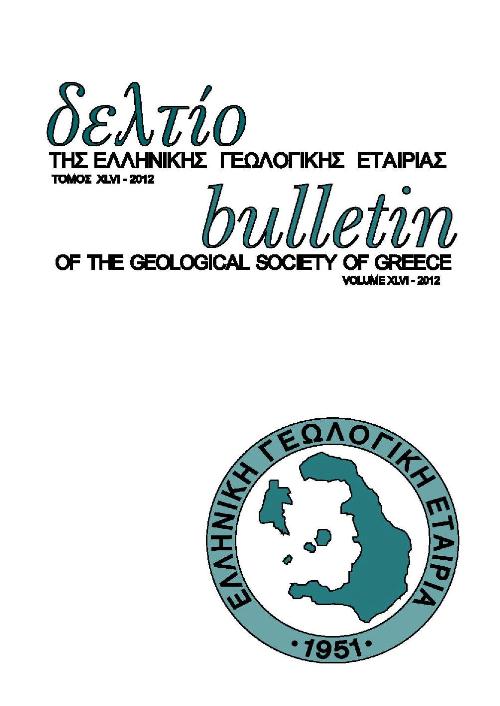Τεχνικογεωλογική συμπεριφορά ηφαιστειακών σχηματισμών με αναφορές σε κατολισθητικά φαινόμενα και οικιστική ανάπτυξη. Παραδείγματα από τη Ν. Λέσβο

Περίληψη
Η τεχνικογεωλογική συμπεριφορά των ηφαιστειακών σχηματισμών έχει διακύμανση μεταξύ εδαφικού και βραχώδους χαρακτήρα και εξαρτάται απο τη γεωλογική σύσταση και προέλευση, το βαθμό αποσάθρωσης και τον βαθμό κερματισμού εφ’όσον είναι βραχώδεις. Στην παρούσα εργασία γίνεται σύντομη αναφορά στην ταξινόμηση της αποσάθρωσης των ηφαιστειακών σχηματισμών. Οι τύποι αστάθειας στους σχηματισμούς αυτούς είναι είτε εδαφικού τύπου (κυρίως υπο τη μορφή περιστροφικών ολισθήσεων και ερπυστικών φαινομένων), είτε βραχώδους τύπου
όπως ολισθήσεις και ανατροπές που ελέγχονται από τα επίπεδα ασυνεχειών του πετρώματος καθώς και καταπτώσεις βράχων. Οι αστοχίες αυτές αποτελούν σημαντικό κίνδυνο σε ανθρώπινες δραστηριότητες. Στο παρόν άρθρο, παρουσιάζονται δύο περιπτώσεις αστοχιών διαφορετικής μορφής σε ηφαιστειακούς σχηματισμούς από την περιοχή του Δήμου Πέτρας, στη Βόρεια Λέσβο. Οι κύριοι γεωλογικοί σχηματισμοί που απαντούν στην περιοχή έρευνας είναι ρυοδακιτικές και λετιανδεσιτικές λάβες, που έχουν βραχώδη χαρακτήρα καθώς και περλίτες, πυριτιωμένες λάβες και πυροκλαστικοί σχηματισμοί (τόφφοι)
που έχουν εδαφικό χαρακτήρα. Επιπροσθέτως, οι ανδεσιτικές λάβες εμφανίζονται σε πολλές θέσεις τελείως αποσαθρωμένες με τη μορφή αργιλικών εδαφών, γεγονός το οποίο συμβάλλει στην εκδήλωση φαινομένων αστάθειας ακόμα και σε πρανή με μικρές κλίσεις. Ο μηχανισμός των συναντώμενων φαινομένων αστάθειας αναλύεται με βάση υπολογιστικές μεθόδους ευστάθειας πρανών. Ειδικότερα,
στην πρώτη περίπτωση έγινε ανάλυση καταπτώσεων βράχων από το πρανές που βρίσκεται ανάντη του χωριού της Στύψης θεωρώντας διαφορετικά υψόμετρα εκκίνησης αυτών καθώς και διαφορετικούς συντελεστές αναπήδησης του υλικού του πρανούς. Δεδομένου, ότι η ανδεσιτική βραχόμαζα παρουσιάζεται με κυμαινόμενο βαθμό αποσάθρωσης, απο υγιής μέχρι μέτρια αποσαθρωμένη, έγινε απομείωση
των συντελεστών αναπήδησης χρησιμοποιώντας την τιμή σκληρότητας σφύρας Schmidt που μετρήθηκε επι τόπου.
Στη δεύτερη περίπτωση, έγινε ανάλυση ευστάθειας εδαφικού πρανούς με βάση τη γεωμετρία της ολισθαίνουσας μάζας και τις γεωλογικές συνθήκες που απαντώνται στη θέση έρευνας. Σημειώνεται, ότι οι σχηματισμοί στη θέση αυτή είναι τόφφοι και τελείως αποσαθρωμένοι ανδεσίτες, με αναλογία βράχου/εδάφους μεταξύ 20 και 30%. Η ανάλυση ευστάθειας έγινε θεωρώντας παραμέτρους του εδαφικού υλικού, ενώ γίνεται αναφορά στη μέθοδο υπολογισμού των ισοδύναμων παραμέτρων του ετερογενούς υλικού, εδάφος με τεμάχη βράχου (block-in-matrix). Τέλος, δημιουργήθηκε ένας απλουστευμένος χάρτης τρωτότητας έναντι ασταθειών της περιοχής έρευνας, που μπορεί να βοηθήσει στην οικιστική ανάπτυξη της περιοχής. Με βάση την εργασία υπαίθρου, οι παράγοντες που καθορίζουν την πιθανή εκδήλωση φαινομένων αστάθειας είναι: α) η κλίση του αναγλύφου και β) η γεωλογική σύσταση των ηφαιστειακών σχηματισμών (βαθμός αποσάθρωσης και περατότητα).
Λεπτομέρειες άρθρου
- Πώς να δημιουργήσετε Αναφορές
-
Saroglou, H. (2012). Τεχνικογεωλογική συμπεριφορά ηφαιστειακών σχηματισμών με αναφορές σε κατολισθητικά φαινόμενα και οικιστική ανάπτυξη. Παραδείγματα από τη Ν. Λέσβο. Δελτίο της Ελληνικής Γεωλογικής Εταιρείας, 46, 108–122. https://doi.org/10.12681/bgsg.10936
- Ενότητα
- Άρθρα

Αυτή η εργασία είναι αδειοδοτημένη υπό το CC Αναφορά Δημιουργού – Μη Εμπορική Χρήση 4.0.
Οι συγγραφείς θα πρέπει να είναι σύμφωνοι με τα παρακάτω: Οι συγγραφείς των άρθρων που δημοσιεύονται στο περιοδικό διατηρούν τα δικαιώματα πνευματικής ιδιοκτησίας επί των άρθρων τους, δίνοντας στο περιοδικό το δικαίωμα της πρώτης δημοσίευσης. Άρθρα που δημοσιεύονται στο περιοδικό διατίθενται με άδεια Creative Commons 4.0 Non Commercial και σύμφωνα με την οποία μπορούν να χρησιμοποιούνται ελεύθερα, με αναφορά στο/στη συγγραφέα και στην πρώτη δημοσίευση για μη κερδοσκοπικούς σκοπούς. Οι συγγραφείς μπορούν να: Μοιραστούν — αντιγράψουν και αναδιανέμουν το υλικό με κάθε μέσο και τρόπο, Προσαρμόσουν — αναμείξουν, τροποποιήσουν και δημιουργήσουν πάνω στο υλικό.




